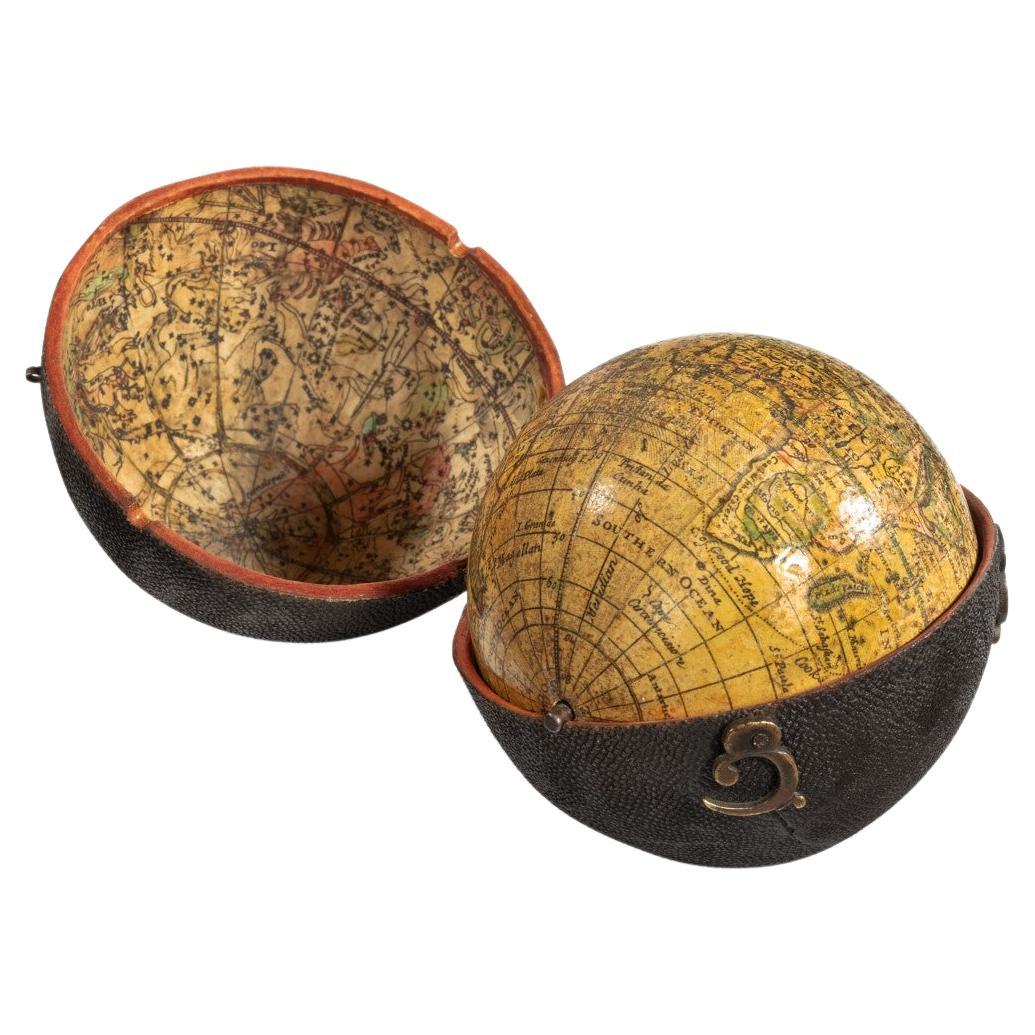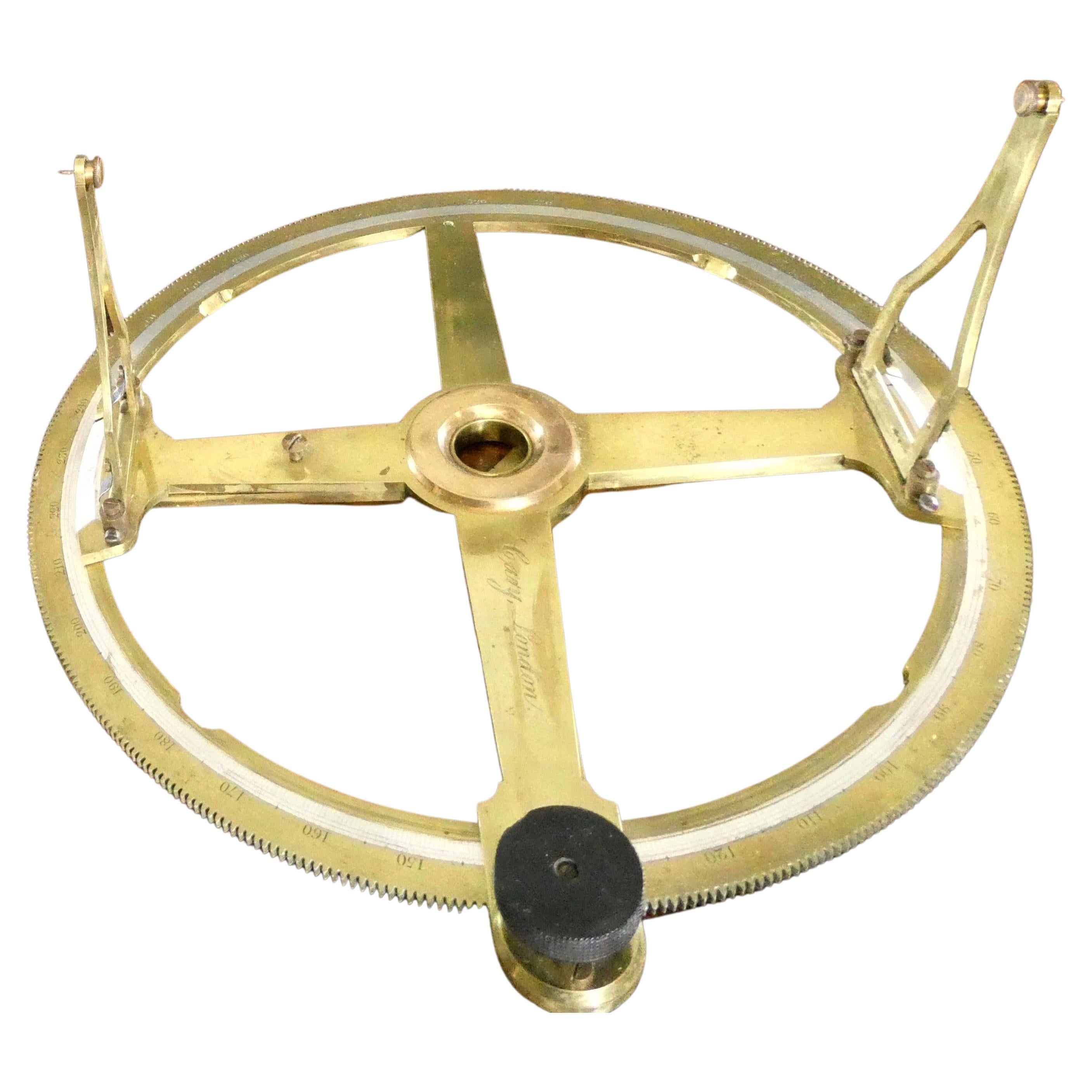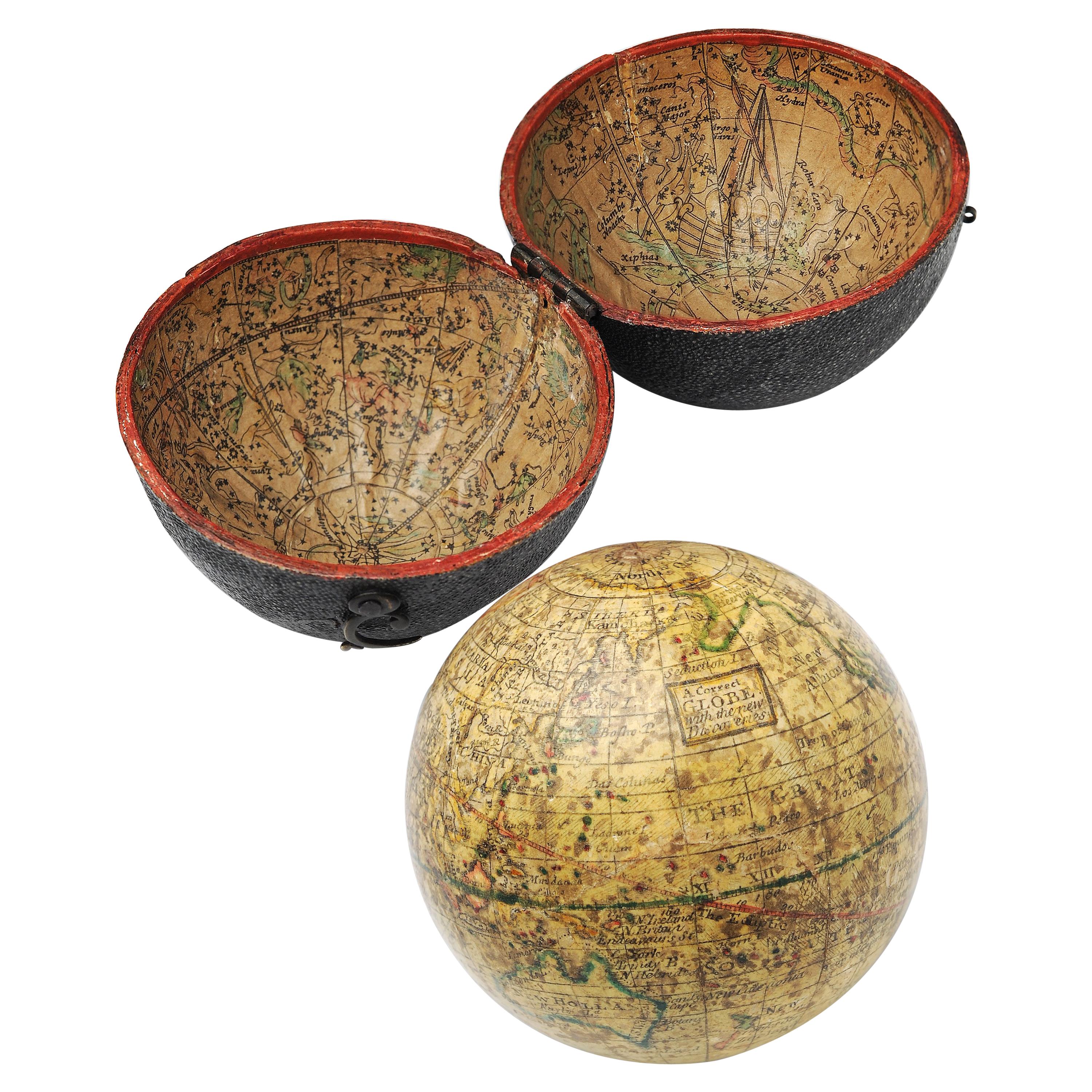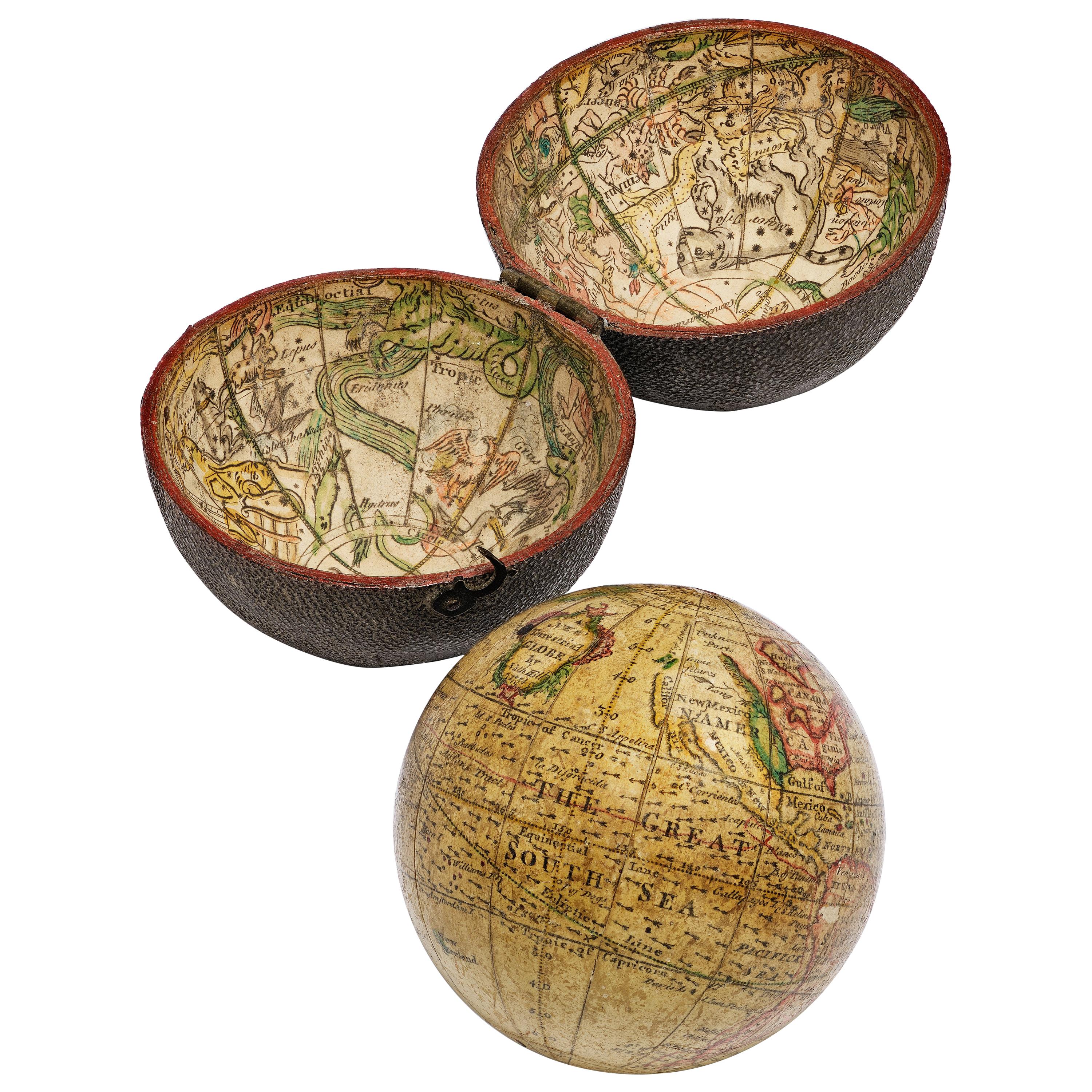Items Similar to Rare George III Celestial Pocket Globe by Cary, London
Want more images or videos?
Request additional images or videos from the seller
1 of 9
Rare George III Celestial Pocket Globe by Cary, London
About the Item
A fine and rare 3" celestial pocket globe by G & W Cary, Strand, London circa 1791, housed in its original sharkskin case.
A companion globe to terrestrial globes of this type were made in much smaller numbers and therefore a great rarity.
- Creator:Cary (Maker)
- Dimensions:Height: 3 in (7.62 cm)Diameter: 3 in (7.62 cm)
- Style:George III (Of the Period)
- Materials and Techniques:
- Place of Origin:
- Period:
- Date of Manufacture:1791
- Condition:Wear consistent with age and use. Superb original condition including lacquer and case.
- Seller Location:Oxfordshire, GB
- Reference Number:1stDibs: LU4936226188322
About the Seller
5.0
Recognized Seller
These prestigious sellers are industry leaders and represent the highest echelon for item quality and design.
1stDibs seller since 2019
20 sales on 1stDibs
Associations
LAPADA - The Association of Arts & Antiques Dealers
- ShippingRetrieving quote...Ships From: Faringdon , United Kingdom
- Return PolicyA return for this item may be initiated within 14 days of delivery.
More From This SellerView All
- Georgian Terrestrial Pocket Globe by T. Harris and Son, London, 1813Located in Oxfordshire, United KingdomA Rare George III pocket globe by T. Harris and Son, London, 1813. Housed in the original sharkskin case. A fasinsting and rare item in wonderful condition. The terrestrial globe inscribed 'New Terrestrial Globe By T.Harris and Sons 1813' rotates on its axes inside a hinged black shagreen case. The concave interior of the case applied with the engraved celestial charts of the Northern and Southern skies and depictatioins of the symbols of Zodiac. The Harris family — Thomas Harris (d. 1837) and his son William Harris (1797-1846) — were London opticians who also sold and later produced terrestrial and celestial globes. Initially, Thomas Harris was principally an optician and mathematical instrument maker. He was joined, and then succeeded, by William in...Category
Antique Early 19th Century English George III Aviation Objects
MaterialsPlaster
- George III Mahogany Stick Barometer by Noted London MakersBy William JonesLocated in Oxfordshire, United KingdomA fine George III mahogany stick barometer by noted London makers William & Samuel Jones. The mahogany-veneered case has an austere form with only the moulded caddy top and the u...Category
Antique Early 19th Century English Georgian Wall Clocks
MaterialsMahogany
- From Queen Charlotte, A Rare Miniature Gold Mounted George III AlmanacLocated in Oxfordshire, United KingdomA presents from Queen Charlotte given to Ann Dundas, Viscountess Melville, The Viscountess was Queen Charlotte’s Lady of the Bedchamber from 1813 until the Queen’s death in 1818. Lon...Category
Antique Early 19th Century English George III Models and Miniatures
MaterialsGold
- From Queen Charlotte, A Rare Miniature Gold Mounted George III Almanac, 1817Located in Oxfordshire, United KingdomA present from Queen Charlotte given to Ann Dundas, Viscountess Melville, The Viscountess was Queen Charlotte’s Lady of the Bedchamber from 1813 until the Queen’s death in 1818. Lond...Category
Antique Early 19th Century English George III Models and Miniatures
MaterialsGold
- A Fine and Rare George III Octagonal Figured Satinwood Box, C.1790Located in Oxfordshire, United KingdomA Fine and Rare Late 18th Century George III Satinwood Octagonal Box, C.1790. The kingwood crossbanded sectional top with ebony and box stringing is finely laid around a central in...Category
Antique 18th Century English George III Tea Caddies
MaterialsKingwood, Satinwood
- George III Ebonized Eight-Day Twin Fusee Table Clock by O. HamleyLocated in Oxfordshire, United KingdomA lovely late George III single pad ebonized eight-day, twin fusee table clock with original verge escapement and rack striking by O. Hamley, circa 1800-1815. The moulded single pad ebonized domed top case with original carrying handle is raised on all four of its original ogee bracket feet onto a detailed base moulding. Gilt-brass sound frets adorn the sides and front in a 'fish scale' pattern backed with bright burgundy silk. The enameled white dial displays Roman numerals, minute and quarter-hour markers housed inside a gilt-brass bezel and domed glass, signed Hamley, Warwick Place, London. The clock features a strike/silent switch on the front dial and a repeat to the right-hand-side. The backplate has border engraving and a short pendulum. Date: 1800-1815 O. Hamley is recorded in Loomes (2006) as being active, circa 1811. He also worked at Bedford Row...Category
Antique Early 1800s English George III Table Clocks and Desk Clocks
MaterialsFruitwood
You May Also Like
- George III Pocket Globe After Herman MollBy Herman MollLocated in Lymington, HampshireA 3 inch George III pocket globe after Herman Moll, the terrestrial globe inscribed in a cartouche ‘A correct globe with the new discoveries’ and fitted within a hinged black shagreen case, the concave interior of the case applied with the engraved celestial charts...Category
Antique 1770s English George III Globes
MaterialsWood
- Pair of English Globes by Cary, London, 1798 and 1800By Cary’sLocated in Milano, ITPair of 12-inch table globes John and William Cary London, 1798 and 1800 Some restored cracks and abrasions lb 11 each (kg 5) The two terrestrial and celestial globes rest in their original Dutch style stands with four supporting turned wood columns. Each one measures 18 in in height x 17 in in diameter with the diameter of the spheres measuring about 12 in; 46 cm in height x 43 cm in diameter x 31 cm diameter of the spheres. The 12 inch measure was one of the most frequently used by British manufacturers of globes of this period. Each globe is composed of two series of twelve printed paper gores, aligned and glued onto plaster spheres. The brass circle of the meridian bears engravings...Category
Antique Late 18th Century English George III Globes
MaterialsWood, Paper
- Fine Circular Protractor by William Cary, London c.1810By CaryLocated in Norwich, GBWilliam Cary, London Circular Protractor. C.1810 The protractor with geared knob turn for full diameter bar, double hinged scribe arms with shaped frame. Main wheel with four spokes and glass sight cross centre, full circumference inscribed divider to 360 degrees signed Cary, London to the bar. Adjustment screws to the arms and housed in it’s original mahogany case with hinged lid. William Cary is listed as working in Strand, London from 1801 to 1825. William Cary was an important scientific instrument maker, he trained under Jesse Ramsden (1735-1800) he produced numerous scientific instruments including mechanical calculators...Category
Antique 1810s English Scientific Instruments
MaterialsBrass
- 18-inch Globe, Cary's, London, 1840By Cary’sLocated in Milano, ITJohn and William Cary Updated by George and John Cary Terrestrial Globe London, 1840 lb 22 (kg 10) Slight surface abrasions due to use. A small crack on the horizon circle. The globe rests in its original Dutch style stand with four supporting turned wood columns. It measures 26 in in height x 23.6 in in diameter with the diameter of the sphere measuring 18 in; 66 cm in height x 60 cm in diameter with the diameter of the sphere measuring 45.72 cm. The 18 inch...Category
Antique 1840s English Early Victorian Globes
MaterialsWood, Paper
- English Pocket Globe, London, Circa 1775-1798By Herman MollLocated in Milano, ITPocket globe London, between 1775 and 1798 Re-edition of the globe of Hermann Moll (1678-1732) dated 1719 The globe is contained in its original case, which itself is covered in sh...Category
Antique Late 18th Century English George III Globes
MaterialsShagreen, Paper
- Pocket Globe by Nathaniel Hill, London 1754Located in Milano, ITNathaniel Hill Pocket globe London, 1754 The globe is contained in its original case, which itself is covered in shark skin. There are slight gaps in the original paint on the sphere. The case no longer closes. The sphere measures 2.6 in (6.8 cm) in diameter whereas the case measures 2.9 in (7.4 cm) in diameter. lb 0.24 (kg 0.11) The globe is made up of twelve printed paper gores aligned and glued to the sphere. In the North Pacific Ocean there is a scroll with the inscription: A New terrestrial Globe by Nath. Hill, 1754. The celestial globe is depicted on the inside of the box. On the terrestrial globe much of central and southern Africa is empty. North America bears only the name of some British colonies. It shows California as a peninsula and the northwest coast of America as "unknown parts" (Alaska is not described and is only partially delineated; it would become part of the United States in 1867). The route of Admiral Anson is traced (1740) and the trade winds are indicated by arrows. Australia, still named New Holland (the new name would be introduced in 1829), is part of the west coast. (See Van der Krogt, P., Old Globes in the Netherlands, Utrecht 1984, p. 146 and Van der Krogt, P. - Dekker, E., Globes from the Western World, London 1993, p. 115.) Nathaniel Hill (London, news from 1746 to 1768) had impeccable professional credentials: he had done his apprenticeship with Richard Cushee, who at the time was carrying out surveying work for John Senex's Surrey map...Category
Antique 1750s English George II Globes
MaterialsShagreen, Paper
Recently Viewed
View AllMore Ways To Browse
Antique London
Used Furniture In London
Antique Furniture London Furniture
Antique Furniture London
Antique Furniture London England
London Antique And Collectable London
Celestial Furniture
Antique Celestial
Small Antique Globes
Celestial Globes
Antique Globes London
Terrestrial Globe
Terrestrial Globes
Celestial Globe
Celestial Terrestrial
Antique Aviation Aviation
Antique Aviation
Antique Celestial Globe





